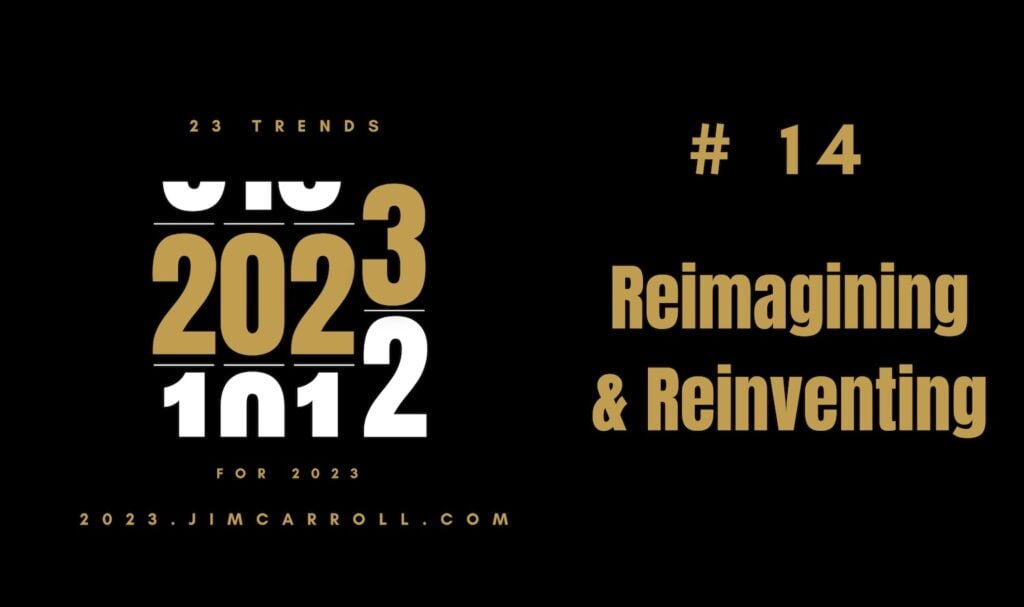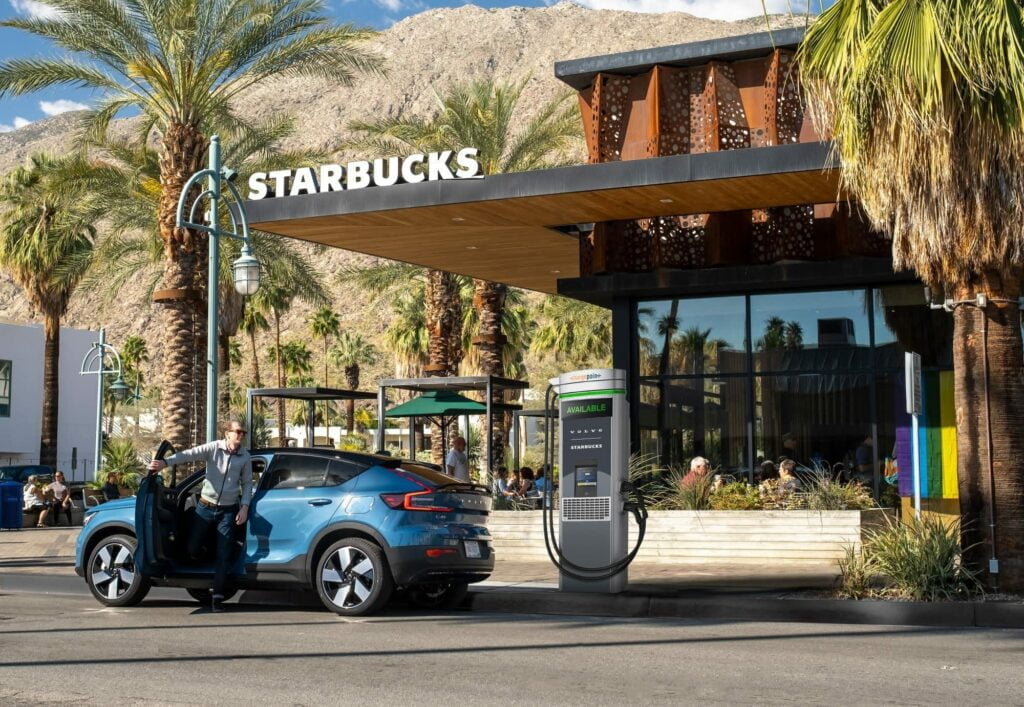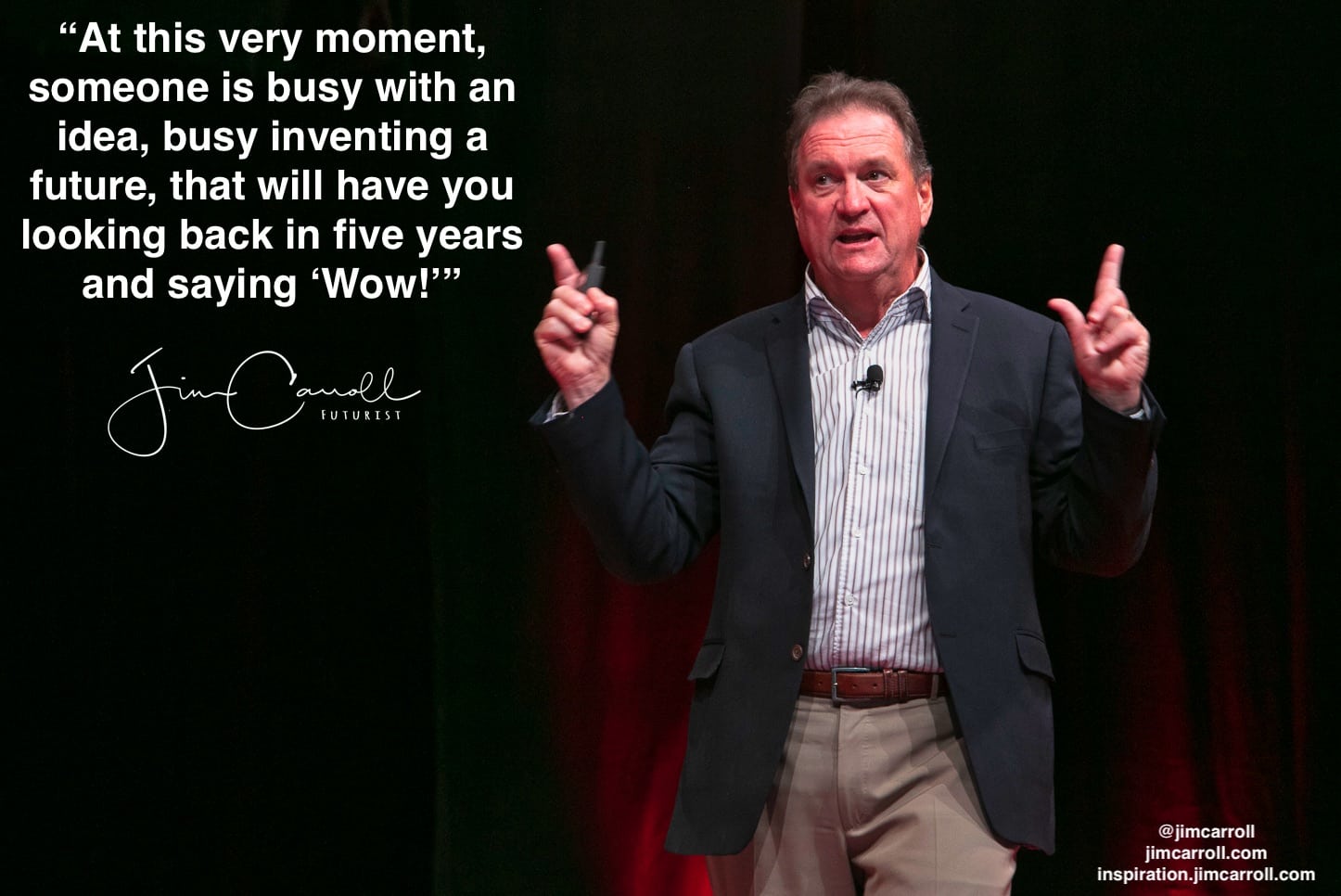If what you sell, who you sell it to, how you sell it, and essentially, what it actually is – you’ve got to change things. If who you are, how you learn, what you know, and what you need to know, you need to reinvent. That means you need to reimagine your future – because it will be fundamentally different from everything you know today.
That’s why trend #14 of my ‘23 Trends for 2023′ is Reimagining & Reinventing.

The Essence of Reinventing Your Future Via Reimagining What it is!
I see a tremendous amount of change within my base of global clients. It goes to the sentence above.
Consider how a truck changes – it’s connected, wired, a hyperconnected rolling platform on wheels:
Here’s what it means for a dealer – reinventing!
What does this lead to? Volvo/Mac trucks have had me in twice for senior-level leadership talks, with a core message that they are reinventing and transforming. The typical truck today contains more technology than a Cessna plane, and the company knows that they are no longer selling a truck – they are selling a service with guaranteed uptime because they know when it is going to break down. They can sell their clients – large fleet operators – a guarantee of uptime. They’re going from selling a truck – to selling something different altogether. That’s reinvention.
This type of thing is happening in every industry. Starbucks is busy reimagining the ‘gas station’ of the future, knowing that when ‘gas’ disappears and electric vehicles become predominant, the opportunity for reinvention of the ‘gas station’ is pretty profound. People will be spending 10-20 minutes for a battery top-up, and will likely spend that time buying coffee and pastries – talk about an opportunity to reinvent the idea of a filling station! Time to reinvent and reimagine and pursue new opportunities!

Philips Medical understands they are no longer selling relatively simple medical devices, but instead, are selling a type of hyperconnected intelligent ‘smart thing; that does medical diagnosis and monitoring. They have essentially changed what they sell – and need to challenge their sales team to think differently as to how to sell it. That’s reinvention – because it’s not a widget anymore!
Heck, the company my son works for – a building inspection firm – recognizes that his drone work fundamentally changes the very nature of an external building inspection, doing it faster, with more accuracy, at less cost, than traditional manual methods. That’s reinvention. The challenge is, it takes a lot of work to get people on the side of reinvention.
Everywhere we look, people are reinventing. In each and everything case, there was a fundamental reimagination of what the future holds in store.
This is your future at a personal level too. Your career will change, your job will evolve, your skills base will change, and your day-to-day activities will be transformed. It’s implicit on you to reinvent, and to do that, reimagine.
Because reinventing and reimaging is what most adults will do for a living from this point forward.
If you aren’t busy reimagining your future, you’ll never reinvent for what comes next.’
Products That Do Not Yet Exist…
At some point in time, if it has not yet happened, you’ll come to realize that the future that you thought you had no longer exists, and that you need to do something new.
And if you are a business organization, that realization brings you the reality that you need to reinvent your revenue.

This resulted in the reality that in an era in which much of your future revenue will come from products or services that don’t yet exist, your legacy might very well be your death sentence!
Let me summarize this reality another way:
“Companies that do not yet exist will build products not yet conceived using materials not yet in existence with methodologies yet to be defined. Are you ready to reinvent to keep up? – Futurist Jim Carroll
What are the driving trends that define a need for regular, continuous revenue reinvention? There are many. Product lifecycles have become shorter; market longevity is not guaranteed; new competitors emerge faster; customers display less loyalty. These trends and many more mean that you don’t have any guarantee that the product or service that you are offering today will be in demand tomorrow – or even relevant.
The Collapse of Product Lifecycles
One of the most profound changes to come about during the past decade has been the collapse of product life cycles.
Think about the graph in your marketing textbook from years or decades ago when you first learned about the concept of product life cycles. Remember how it showed a product coming to market: sales increase, reach market maturity and eventually begin to drop off. That’s been the model of product life cycles as taught in business schools for the past 100 years or so.
The rule of thumb was that companies would innovate and introduce a new product. If it succeeded, the company would experience growth. At some point, sales would peak. The product would then become obsolete or overtaken by competitors and sales would decline. That might involve a time period of 10, 15, or even 25 years.
What a quaint model. Too bad it bears no resemblance to today’s reality. The product life-cycle model today is being turned on its ear by instant obsolescence. In some industries, that product obsolescence now occurs during the growth stage; in the high-tech industry, the decline phase caused by instant obsolescence can occur during the introduction of a product or even before a product makes it to the marketplace.
Technology Driven Hyper-trends
Behind these trends are myriad factors. As every industry becomes one driven by the speed of technology and hyper-connectivity (“cars become computers”), the pace of industry speeds up to a furious degree. Existing products become out of date faster, and new products based on new connected concepts emerge – the basis of revenue transforms.
That’s why you need to focus on the concept of continuous reinvention – a mindset that today’s line of products or services is not good enough – and must be refreshed and reinvented on a regular, continuous basis.
The harbinger for this trend was found with the blistering pace set by Apple – at one moment, Apple was in a situation in which 60% of its revenue came from products that did not exist 5 years prior. Once an aberration, that is increasingly becoming the norm in most industries. If you can’t reinvent at the same blistering pace, you’re done.
Can you reinvent yourself at the same blistering pace as Apple and other hi-tech companies? If not, you’d better figure it out – your market and industry are becoming part of that same reality.
Consider the trend. Cars are becoming computers. Home appliances are now connected to computers that wash your clothes and cook your food. Medical equipment is now some sort of weird, hyperconnected intelligent AI thing that does a better job at diagnoses than a physician. A farm tractor is no longer just that – it is now a rolling GPS-based real-time soil-weed-crop health analysis machine!
In all of these cases, Silicon Valley and the impact of technology have come to drive the speed of change – and quite simply, that’s faster. Companies need to pick up the innovation pace – and reinvent their revenue in doing so.
Rapid product obsolescence
They also need to recognize that as their industries become tech-driven industries, the products they bring to market become irrelevant faster.
Who wants a car dashboard from the olden days (i.e. from two years ago) when this year’s model has the latest, greatest car navigation and accident avoidance technology?
Who in their right mind wants to invest in a microwave oven when they know that intelligent hyperconnected smart-packaging bar code technology just on the horizon will determine optimal cooking times?
Who wants to build a hospital using yesterday’s out-of-date medical equipment when there is some fascinating new device just on the horizon?
If you can’t reinvent, you don’t survive. Your customers won’t put up with it. Their mind is already far ahead of you because increasingly, they know what comes next, and that’s what they want!
Fundamental Industry Transformation
It’s not just hi-tech trends that are driving revenue reinvention – it is the fact that we are witnessing many existing industries enter into their sunset years, driven by the real emergence of new industries.
For example, oil is over. We all know this to be a fact. Massive oil companies like BP, Saudi Aramco, and others have said that there are countless other trends that are leading to the end of the era of carbon – renewables, micro-grids, electric vehicles, battery storage technology.
Saudi Aramco? The largest oil company in the world Simply put, they know oil is over, that chemical science is the future, and that rapid reinvention is critical – and that their future lies in turning itself into a chemicals company instead..
The Acceleration of Science
Why would one of the world’s largest oil companies shift to a new focus on the chemical industry as their key opportunity?
One reason is the math of chemical hyper science.
Years ago, I dug out a fascinating observation having to do with the world of chemistry.
- “…The number of known chemical substances has been growing exponentially since 1800, from some hundreds then to about 19 million today….”
- “…. the number constantly doubles every 13 years….”
- by 2025: 80 million chemical substances
- by 2050: 300 million
- and by 2100: 5 billion……
19 billion known chemical substances to 5 billion? That’s a pretty exponential change…
Here’s the thing – it was the discovery of a single new chemical substance that led to the opportunity for Apple to miniaturize the hard drive — that led to the first iPod – many years ago. Which was the birth of a multi-billion market.
For every new chemical substance, similar massive new opportunities exist.
That’s what it means to live in an exponential world! And that is what it means to focus on future opportunities through innovation. This is precisely what Said Aramco is focused on…. Chemistry!
Continuous revenue reinvention
Then there is revenue reinvention which comes from changing existing business processes to change up the mix of revenue faster.
A great case study involves a company such as Honda, which can see what’s selling strongly and quickly reorient its production to fit that demand. In the meantime, its competitors are busy cranking out 700,000 versions of the same old car, hoping to sell it to consumers who have already moved on to something different.
Everyone now understands that the old Detroit-based manufacturing business model was deeply flawed. The newer model, based on agility and flexibility, is the model of the future. If an organization can rapidly change its production to accommodate what consumers are willing to buy, it has a good chance of future success.
Disruptive trends reinvention
This ability to respond quickly to change is a cornerstone of opportunity. Competitors will emerge, particularly as the new connected generation rejects existing business models and innovative people continue to shake up the fundamentals.
The Concept of Chameleon Revenue
I recently spoke at a leadership meeting for a global organization, where the CEO spoke of a future in which the company’s success would come from what he called “chameleon revenue” — the sales derived from entirely new product lines. The chart he presented said it all: the organization’s future consisted of a steady decrease in baseline revenue and accelerating revenue streams from markets it currently does not participate.
I think this will become the norm for most organizations. The ability to rapidly enter and exit markets will define future success. The ability to sustain multiple, short-term product life cycles, each perhaps no more than 36 to 48 months long, will be a critical success factor. Agility at discovering, producing, and capitalizing on new revenue sources will be a fundamental necessity. In other words, your ability to change your spots and your color on a dime will be the key driver for your potential.
Your Reality Going Forward
Can you reinvent revenue at speed? What if you had to replenish your product or service line every two or three years? It could become the new normal in many industries.
Can you imagine how different your future will be?
If you want to master reinvention you need to think about how your own product life cycle is changing.
If product life cycles are collapsing in your industry, do you have the capability and wherewithal to generate revenue where revenue hasn’t existed before? Are you prepared to bust into new business models so you can enter markets where you haven’t participated before? Do you know how to add service and other revenue streams to commodity product lines so that you can generate additional revenue from previously stale product lines?
Your ability to survive and thrive in the future is going to come from your ability to generate new sources of revenue and adopt – and reimagine and reinvent!




GET IN TOUCH
Jim's Facebook page
You'll find Jim's latest videos on Youtube
Mastodon. What's on Jim's mind? Check his feed!
LinkedIn - reach out to Jim for a professional connection!
Flickr! Get inspired! A massive archive of all of Jim's daily inspirational quotes!
Instagram - the home for Jim's motivational mind!